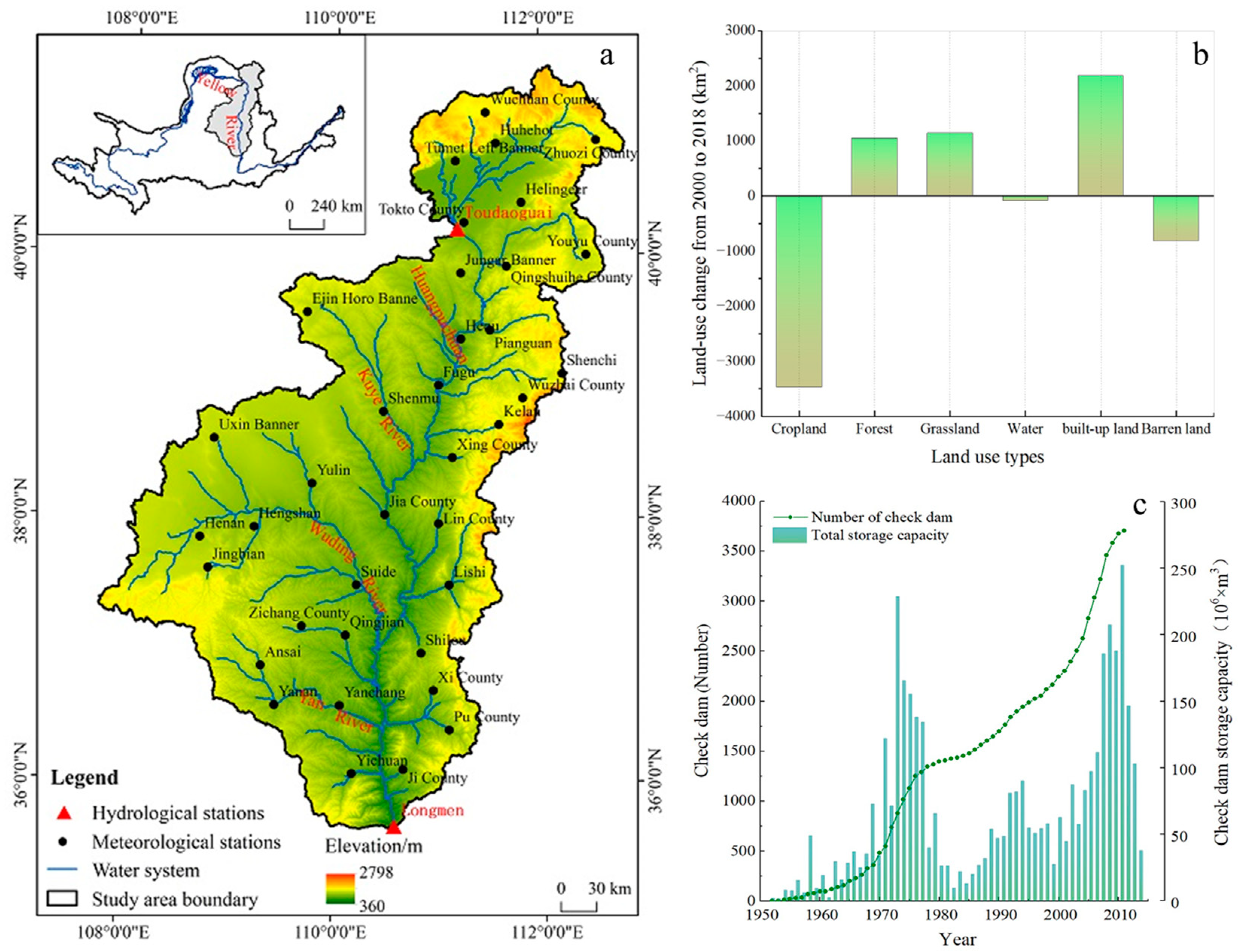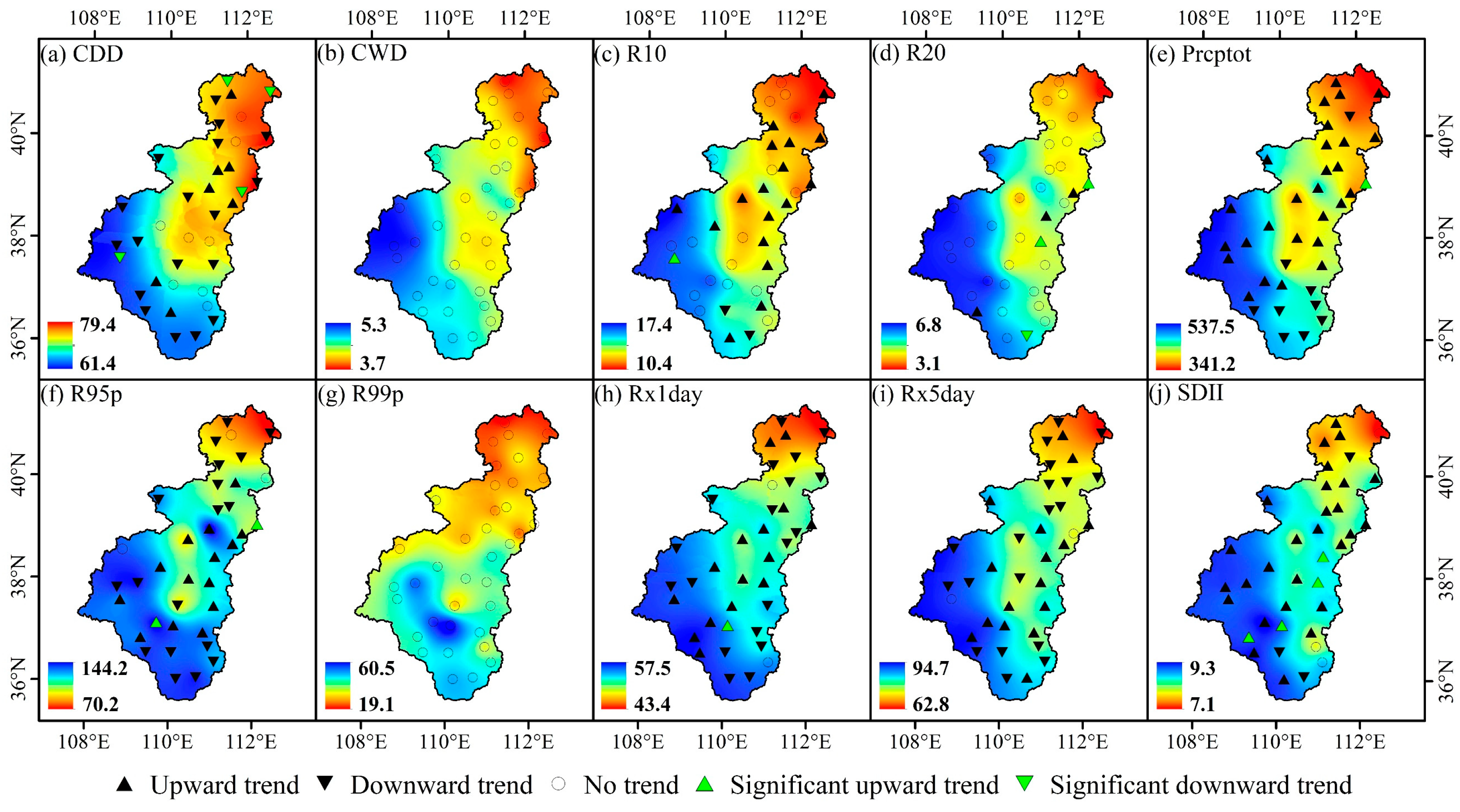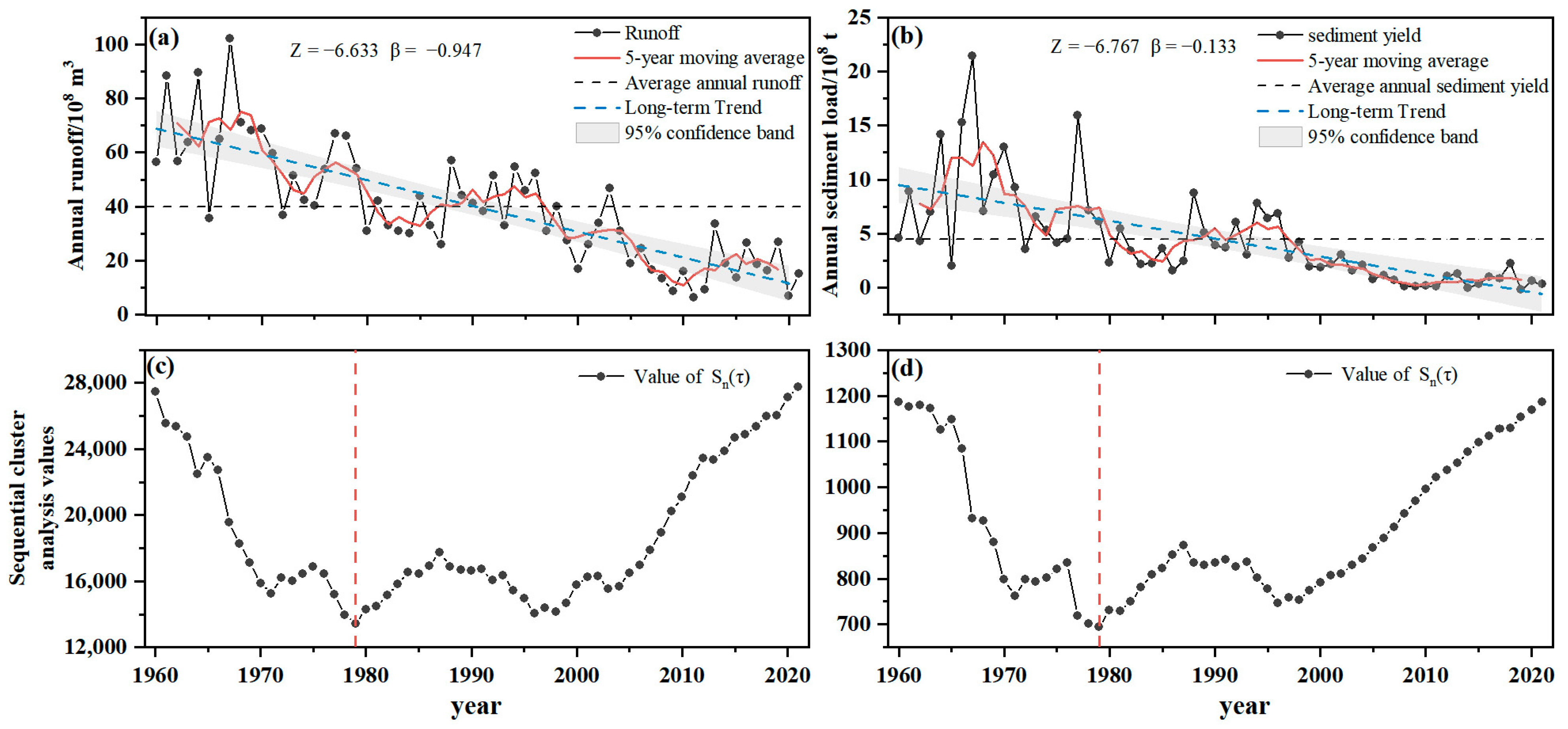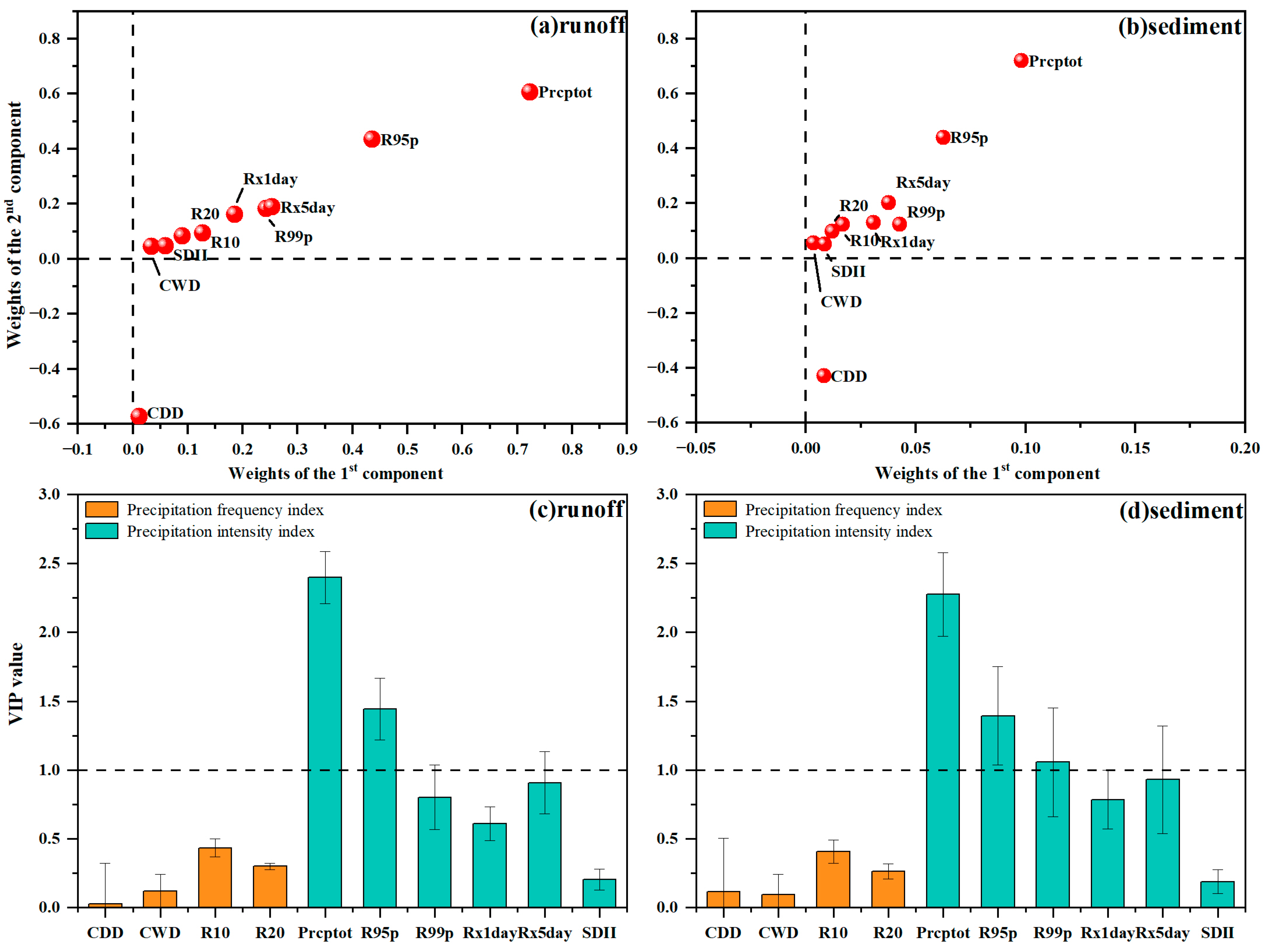Effects of Extreme Precipitation on Runoff and Sediment Yield in the Middle Reaches of the Yellow River
Abstract
:1. Introduction
2. Materials and Methods
2.1. Study Area
2.2. Data Sources
2.3. Methods
2.3.1. Extreme Precipitation Indices
2.3.2. Spatial–Temporal Analysis
2.3.3. Change Point Analysis
2.3.4. PLSR Model
2.3.5. Attribute Analysis of Runoff and Sediment Yield Change
3. Results
3.1. The Spatio-Tempora Variation Characteristics of Extreme Precipitation
3.2. Temporal Trends of Runoff and Sediment Yield
3.3. Effects of Extreme Precipitation on Runoff and Sediment Yield Changes
4. Discussion
4.1. Characteristics of Extreme Precipitation in the Toudaoguai–Longmen Section under Changing Climate
4.2. Effects of Extreme Precipitation on Runoff and Sediment Yield in the Toudaoguai–Longmen Section
5. Conclusions
Author Contributions
Funding
Institutional Review Board Statement
Informed Consent Statement
Data Availability Statement
Conflicts of Interest
References
- Gimeno, L.; Sori, R.; Vazquez, M.; Stojanovic, M.; Algarra, I.; Eiras-Barca, J.; Gimeno-Sotelo, L.; Nieto, R. Extreme precipitation events. WIREs Water 2022, 9, e1611. [Google Scholar] [CrossRef]
- Giorgi, F.; Raffaele, F.; Coppola, E. The response of precipitation characteristics to global warming from climate projections. Earth Syst. Dyn. 2019, 10, 73–89. [Google Scholar] [CrossRef]
- Wang, H.; Huang, Y.; Zhang, D.; Wang, H. Decadal prediction of the summer extreme precipitation over southern China. Atmosphere 2023, 14, 595. [Google Scholar] [CrossRef]
- Asadieh, B.; Krakauer, N.Y. Global trends in extreme precipitation: Climate models versus observations. Hydrol. Earth Syst. Sci. 2015, 19, 877–891. [Google Scholar] [CrossRef]
- Chou, C.; Chiang, J.C.H.; Lan, C.W.; Chung, C.H.; Liao, Y.C.; Lee, C.J. Increase in the range between wet and dry season precipitation. Nat. Geosci. 2013, 6, 263–267. [Google Scholar] [CrossRef]
- Donat, M.G.; Alexander, L.V.; Yang, H.; Durre, I.; Vose, R.; Dunn, R.J.H.; Willett, K.M.; Aguilar, E.; Brunet, M.; Caesar, J.; et al. Updated analyses of temperature and precipitation extreme indices since the beginning of the twentieth century: The HadEX2 dataset. J. Geophys. Res. Atmos. 2013, 118, 2098–2118. [Google Scholar] [CrossRef]
- Roxy, M.K.; Ghosh, S.; Pathak, A.; Athulya, R.; Mujumdar, M.; Murtugudde, R.; Terray, P.; Rajeevan, M. A threefold rise in widespread extreme rain events over central India. Nat. Commun. 2017, 8, 708. [Google Scholar] [CrossRef]
- Do, H.X.; Mei, Y.; Gronewold, A.D. To what extent are changes in flood magnitude related to changes in precipitation extremes? Geophys. Res. Lett. 2020, 47, e2020GL088684. [Google Scholar] [CrossRef]
- Wu, L.; Chen, D.; Yang, D.; Luo, G.; Wang, J.; Chen, F. Response of runoff change to extreme climate evolution in a typical watershed of Karst trough valley, SW China. Atmosphere 2023, 14, 927. [Google Scholar] [CrossRef]
- Nanditha, J.S.; Mishra, V. Multiday precipitation is a prominent driver of floods in Indian river basins. Water Resour. Res. 2022, 58, e2022WR032723. [Google Scholar] [CrossRef]
- Kundzewicz, Z.W.; Kanae, S.; Seneviratne, S.I.; Handmer, J.; Nicholls, N.; Peduzzi, P.; Mechler, R.; Bouwer, L.M.; Arnell, N.; Mach, K.; et al. Flood risk and climate change: Global and regional perspectives. Hydrol. Sci. J. 2014, 59, 1–28. [Google Scholar] [CrossRef]
- Sharma, A.; Wasko, C.; Lettenmaier, D.P. If precipitation extremes are increasing, why aren’t floods? Water Resour. Res. 2018, 54, 8545–8551. [Google Scholar] [CrossRef]
- Ran, Q.; Zong, X.; Ye, S.; Gao, J.; Hong, Y. Dominant mechanism for annual maximum flood and sediment events generation in the Yellow River basin. Catena 2020, 187, 104376. [Google Scholar] [CrossRef]
- Gao, P.; Deng, J.; Chai, X.; Mu, X.; Zhao, G.; Shao, H.; Sun, W. Dynamic sediment discharge in the Hekou–Longmen region of Yellow River and soil and water conservation implications. Sci. Total Environ. 2017, 578, 56–66. [Google Scholar] [CrossRef] [PubMed]
- Xu, Z.; Zhang, S.H.; Yang, X.Y. Water and sediment yield response to extreme rainfall events in a complex large river basin: A case study of the Yellow River Basin, China. J. Hydrol. 2021, 597, 126183. [Google Scholar] [CrossRef]
- Zhao, Y.; Xu, X.; Huang, W.; Wang, Y.; Xu, Y.; Chen, H.; Kang, Z. Trends in observed mean and extreme precipitation within the Yellow River Basin, China. Theor. Appl. Climatol. 2019, 136, 1387–1396. [Google Scholar] [CrossRef]
- Li, Z.; Zheng, F.L.; Liu, W.Z.; Jiang, D.J. Spatially downscaling GCMs outputs to project changes in extreme precipitation and temperature events on the Loess Plateau of China during the 21st Century. Glob. Planet. Chang. 2012, 82–83, 65–73. [Google Scholar] [CrossRef]
- Zhang, Y.; Xia, J.; She, D.X. Spatiotemporal variation and statistical characteristic of extreme precipitation in the middle reaches of the Yellow River Basin during 1960–2013. Theor. Appl. Climatol. 2019, 135, 391–408. [Google Scholar] [CrossRef]
- Zhang, P.; Sun, W.; Xiao, P.; Yao, W.; Liu, G. Driving factors of heavy rainfall causing flash floods in the middle reaches of the Yellow River: A case study in the Wuding River Basin, China. Sustainability 2022, 14, 8004. [Google Scholar] [CrossRef]
- Li, P.; Xu, G.; Lu, K.; Zhang, X.; Shi, P.; Bai, L.; Ren, Z.; Pang, G.; Xiao, L.; Gao, H.; et al. Runoff change and sediment source during rainstorms in an ecologically constructed watershed on the Loess Plateau, China. Sci. Total Environ. 2019, 664, 968–974. [Google Scholar] [CrossRef]
- Zhao, Y.; Cao, W.H.; Hu, C.H.; Wang, Y.S.; Wang, Z.Y.; Zhang, X.M.; Zhu, B.S.; Cheng, C.; Yin, X.L.; Liu, B.; et al. Analysis of changes in characteristics of flood and sediment yield in typical basins of the Yellow River under extreme rainfall events. Catena 2019, 177, 31–40. [Google Scholar] [CrossRef]
- Gao, H.; Liu, H.; Jia, L.; Pang, G.; Wang, J. Attribution analysis of precipitous decrease of sediment loads in the Hekou-Longmen section of Yellow River since 2000. Acta Geogr. Sin. 2019, 74, 1745–1757. (In Chinese) [Google Scholar] [CrossRef]
- Tank, A.K.M.C.; Zwiers, F.W.; Zhang, X. Guidelines on Analysis of Extremes in a Changing Climate in Support of Informed Decisions for Adaptation; World Meteorological Organization (WMO): Geneva, Switzerland, 2009. [Google Scholar]
- Cooley, A.K.; Chang, H. Detecting change in precipitation indices using observed (1977–2016) and modeled future climate data in Portland, Oregon, USA. J. Water Clim. Chang. 2020, 12, 1135–1153. [Google Scholar] [CrossRef]
- Zhang, X.B.; Yang, F. RClimDex(1.0) UserManual; Climate Research Branch Environment: Toronto, ON, Canada, 2004. [Google Scholar]
- Hamed, K.H.; Ramachandra Rao, A. A modified Mann-Kendall trend test for autocorrelated data. J. Hydrol. 1998, 204, 182–196. [Google Scholar] [CrossRef]
- Sen, P.K. Estimates of the regression coefficient based on Kendall’s Tau. J. Am. Stat. Assoc. 1968, 63, 1379–1389. [Google Scholar] [CrossRef]
- Sun, J.; Wang, X.; Shahid, S. Precipitation and runoff variation characteristics in typical regions of North China Plain: A case study of Hengshui City. Theor. Appl. Climatol. 2020, 142, 971–985. [Google Scholar] [CrossRef]
- Liu, W.; Li, Z.; Zhu, J.; Xu, C.; Xu, X. Dominant factors controlling runoff coefficients in karst watersheds. J. Hydrol. 2020, 590, 125486. [Google Scholar] [CrossRef]
- Du, H.; Alexander, L.V.; Donat, M.G.; Lippmann, T.; Srivastava, A.; Salinger, J.; Kruger, A.; Choi, G.; He, H.S.; Fujibe, F.; et al. Precipitation from persistent extremes is increasing in most regions and globally. Geophys. Res. Lett. 2019, 46, 6041–6049. [Google Scholar] [CrossRef]
- Li, L.; Yao, N.; Liu, D.L.; Song, S.; Lin, H.; Chen, X.; Li, Y. Historical and future projected frequency of extreme precipitation indicators using the optimized cumulative distribution functions in China. J. Hydrol. 2019, 579, 124170. [Google Scholar] [CrossRef]
- Gao, T.; Wang, H.L. Trends in precipitation extremes over the Yellow River basin in North China: Changing properties and causes. Hydrol. Process. 2017, 31, 2412–2428. [Google Scholar] [CrossRef]
- Liu, H.; Zhou, T.; Zhu, Y.; Lin, Y.H. The strengthening East Asia summer monsoon since the early 1990s. Chin. Sci. Bull. 2012, 57, 765–769. [Google Scholar] [CrossRef]
- Cai, Q.; Liu, Y.; Fang, C.; Xie, M.; Zhang, H.; Li, Q.; Song, H.; Sun, C.; Liu, R.; Di, T.; et al. Insight into spatial-temporal patterns of hydroclimate change on the Chinese Loess Plateau over the past 250 years, using new evidence from tree rings. Sci. Total Environ. 2022, 850, 157960. [Google Scholar] [CrossRef]
- Das, S.; Zhu, D.; Cheng, C.H. A regional approach of decadal assessment of extreme precipitation estimates: A case study in the Yangtze River Basin, China. Pure Appl. Geophys. 2020, 177, 1079–1093. [Google Scholar] [CrossRef]
- Das, S.; Zhu, D. Comparison between observed and remotely sensed attributes to include in the region-of-influence approach of extreme precipitation estimation: A case study in the Yangtze River basin, China. Hydrol. Sci. J. 2021, 66, 1777–1789. [Google Scholar] [CrossRef]
- Xie, M.; Ren, Z.; Li, Z.; Zhang, X.; Ma, X.; Li, P.; Shen, Z. Evolution of the precipitation–stream runoff relationship in different precipitation scenarios in the Yellow River Basin. Urban Clim. 2023, 51, 101609. [Google Scholar] [CrossRef]
- Ivancic, T.J.; Shaw, S.B. Examining why trends in very heavy precipitation should not be mistaken for trends in very high river discharge. Clim. Chang. 2015, 133, 681–693. [Google Scholar] [CrossRef]
- Zhang, J.; Gao, G.; Li, Z.; Fu, B.; Gupta, H.V. Identification of climate variables dominating streamflow generation and quantification of streamflow decline in the Loess Plateau, China. Sci. Total Environ. 2020, 722, 137935. [Google Scholar] [CrossRef]
- Gao, G.; Zhang, J.; Liu, Y.; Ning, Z.; Fu, B.; Sivapalan, M. Spatio-temporal patterns of the effects of precipitation variability and land use/cover changes on long-term changes in sediment yield in the Loess Plateau, China. Hydrol. Earth Syst. Sci. 2017, 21, 4363–4378. [Google Scholar] [CrossRef]
- Wang, K.; Deng, L.; Shangguan, Z.; Chen, Y.; Lin, X. Sustainability of eco-environment in semi-arid regions: Lessons from the Chinese Loess Plateau. Environ. Sci. Policy 2021, 125, 126–134. [Google Scholar] [CrossRef]
- Yin, S.; Gao, G.; Ran, L.; Li, D.; Lu, X.; Fu, B. Extreme streamflow and sediment load changes in the Yellow River Basin: Impacts of climate change and human activities. J. Hydrol. 2023, 619, 129372. [Google Scholar] [CrossRef]
- Liu, B.; Yao, W.; Liu, G.; An, S.; Han, J.; Cao, W.; Dang, W.; Jiao, J. Comprehensive Investigation Report on “7.26” Heavy Rainstorm Flood, and Soil and Water Conservation Benefits in the Loess Plateau; Science Press: Beijing, China, 2020. (In Chinese) [Google Scholar]





| Indices | Definitions | Units |
|---|---|---|
| Consecutive dry days (CDD) | The maximum length of a dry spell (RR < 1 mm) in a year; let RRi be the daily precipitation amount on day i in a year; count the largest number of consecutive days where RRi < 1 mm. | day |
| Consecutive wet days (CWD) | The maximum length of a wet spell (RR > 1 mm) in a year; let RRi be the daily precipitation amount on day i in a year; count the largest number of consecutive days where RRi > 1 mm. | day |
| Heavy precipitation days (R10) | Count of days where RR (daily precipitation amount) ≥ 10 mm, let RRi be the daily precipitation amount on day i in a year. Count the number of days where RRi ≥ 10 mm. | day |
| Very heavy precipitation days (R20) | Count of days where RR (daily precipitation amount) ≥ 20 mm, let RRi be the daily precipitation amount on day i in a year. Count the number of days where RRi ≥ 20 mm. | day |
| Annual total wet-day precipitation (Prcptot) | Accumulated precipitation with daily precipitation > 1 mm in a year. | mm |
| Simple daily intensity index (SDII) | Mean precipitation amount on a wet day.Taking the sum of precipitation in wet days (days with >1 mm of precipitation), and dividing that by the number of wet days in a year d | mm/d |
| Very wet days (R95p) | Annual cumulative precipitation with daily precipitation > 95% quantile | mm |
| Extreme wet days (R99p) | Annual cumulative precipitation with daily precipitation > 99% quantile | mm |
| Highest one-day precipitation amount (Rx1day) | Annual maximum 1-day precipitation | mm |
| Highest five-day precipitation amount (Rx5day) | Annual maximum consecutive five-day precipitation | mm |
| Factor | R2 | Q2 | Component | Explanation/% | Cumulative Explanation/% | |
|---|---|---|---|---|---|---|
| Runoff | 0.858 | 0.798 | 1 | 68.5 | 68.5 | 0.655 |
| 2 | 17.3 | 85.8 | 0.798 | |||
| Sediment | 0.637 | 0.511 | 1 | 41.9 | 41.9 | 0.333 |
| 2 | 21.8 | 63.7 | 0.511 |
| Time Period | Measured Runoff Depth/mm | Simulated Runoff Depth/mm | Measured Flow Reduction | Impact of Extreme Precipitation | Impact of Human Activities | |||
|---|---|---|---|---|---|---|---|---|
| mm | % | mm | % | mm | % | |||
| 1960–1979 | 48.4 | / | / | / | / | / | / | / |
| 1980–1999 | 30.8 | 42.2 | 17.6 | 36.4 | 6.2 | 35.3 | 11.4 | 64.7 |
| 2000–2021 | 15.9 | 46.4 | 32.5 | 67.2 | 2.0 | 6.2 | 30.5 | 93.8 |
| Time Period | Measured Sediment Load/t/km2 | Simulated Sediment Load/t/km2 | Measured Sediment Load Change | Impact of Extreme Precipitation | Impact of Other Factors | |||
|---|---|---|---|---|---|---|---|---|
| t/km2 | % | t/km2 | % | t/km2 | % | |||
| 1960–1979 | 6678.7 | / | / | / | / | / | / | / |
| 1980–1999 | 3287.1 | 3819.6 | 3391.6 | 50.8 | 2859.0 | 84.3 | 532.5 | 15.7 |
| 2000–2021 | 765.8 | 4313.4 | 5912.9 | 88.5 | 2365.3 | 40.0 | 3547.6 | 60.0 |
Disclaimer/Publisher’s Note: The statements, opinions and data contained in all publications are solely those of the individual author(s) and contributor(s) and not of MDPI and/or the editor(s). MDPI and/or the editor(s) disclaim responsibility for any injury to people or property resulting from any ideas, methods, instructions or products referred to in the content. |
© 2023 by the authors. Licensee MDPI, Basel, Switzerland. This article is an open access article distributed under the terms and conditions of the Creative Commons Attribution (CC BY) license (https://creativecommons.org/licenses/by/4.0/).
Share and Cite
Ren, Z.; Ma, X.; Wang, K.; Li, Z. Effects of Extreme Precipitation on Runoff and Sediment Yield in the Middle Reaches of the Yellow River. Atmosphere 2023, 14, 1415. https://doi.org/10.3390/atmos14091415
Ren Z, Ma X, Wang K, Li Z. Effects of Extreme Precipitation on Runoff and Sediment Yield in the Middle Reaches of the Yellow River. Atmosphere. 2023; 14(9):1415. https://doi.org/10.3390/atmos14091415
Chicago/Turabian StyleRen, Zongping, Xiaoni Ma, Kaibo Wang, and Zhanbin Li. 2023. "Effects of Extreme Precipitation on Runoff and Sediment Yield in the Middle Reaches of the Yellow River" Atmosphere 14, no. 9: 1415. https://doi.org/10.3390/atmos14091415






